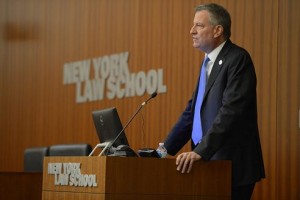
Mayor De Blasio at New York Law School. Image Credit: CityLand
Mayor and City Council celebrate progress in production of affordable housing units since the passage of mandatory affordable rules one year ago. March 22, 2017, marked the one year anniversary of the Mandatory Inclusionary Housing program. The program, which requires developers to include permanently affordable housing whenever a special permit or a rezoning significantly increases the underlying potential residential floor area, has received both praise and chastisement from advocates and Council Members.
Considerable consternation surrounded the passage of the housing program. Detractors of the program argued that allowing taller, denser buildings in low-income neighborhoods would produce a glut of market rate apartments that local residents could never afford. Even the percentage of “affordable housing” would be too expensive for New York City households—approximately one-third of households make less than $35,000 a year, and one-half make less than $50,000. This initially led to 50 of 59 impacted community boards formally rejecting the plan, alongside four of the five borough presidents.
The full City Council approved the Mandatory Inclusionary Housing program by a vote of 42-5, with Council Members Inez Barron, Joe Borelli, Barry Grodenchik, Jumaane Williams, and Steven Matteo voting against.
Much fervor has been vented about the program in its first year. On August 16, 2016, the City Council rejected a proposal to rezone a large corner lot in order to construct a new mixed-use development located at 4650 Broadway in Manhattan’s Inwood neighborhood. The project received harsh criticism from the area’s representative, Council Member Ydanis Rodriguez, who sought and received concessions from the developer to decrease the height of the building and increase the portion of affordable units. Public outcry, however, led to the disapproval of the project.
Another project in Sunnyside, Queens found its end in the affordable housing conflagration. On September 20, 2016, Phipps Houses, the oldest and largest not-for-profit developer of affordable housing in New York City, withdrew its Barnett Avenue development proposal—the day before its scheduled public hearing in front of the City Council’s Subcommittee on Zoning and Franchises. The project would have created a seven- to ten-story residential building containing 232,237 square feet of residential space and 4,800 square feet of ground floor community facility space. The community board and the borough president both expressed concerns that the affordable housing would still be too expensive for Sunnyside residents, and recommended denial. City Council Member Jimmy Van Bramer, who represents the Sunnyside neighborhood, had been vocally opposed to the project as well.
As the Mandatory Inclusionary Program has reached its one year mark, Mayor Bill de Blasio and the City Council have cause to celebrate some measurable progress. Eleven applications for approximately 4,700 new affordable units have been approved by the Council—of those at least 1,600 will be permanently affordable.
“Among our most important achievements as we strive to secure affordability for millions of New Yorkers was passing these historic zoning changes, Mandatory Inclusionary Housing and Zoning for Quality & Affordability. With them, we will build tens of thousands of affordable homes for seniors, veterans and working families,” said Mayor Bill de Blasio.
“After hearing the concerns from communities across New York City and after months of deliberations last year the City Council adopted with significant changes two far reaching proposals to better align our housing policy with the real housing needs of New Yorkers. Since then the Council has voted on a number of projects which will produce thousands of affordable units for New Yorkers with many more affordable apartments on the way,” said Council Speaker Melissa Mark-Viverito.
By: Jonathon Sizemore (Jonathon is the CityLaw Fellow and a New York Law School Graduate, Class of 2016).

